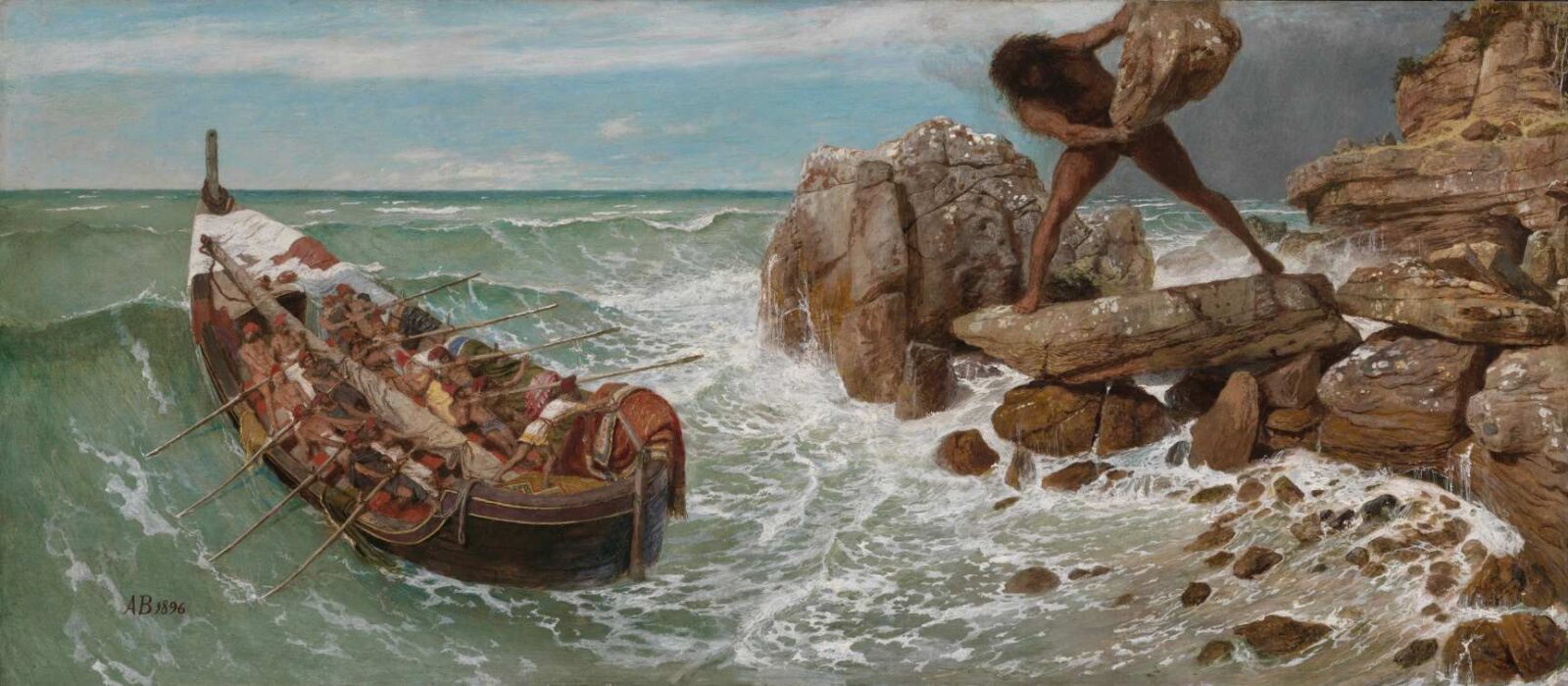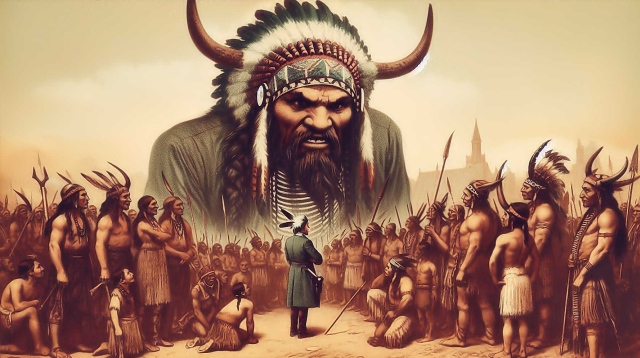Unveiling the Mysteries of Cyclops and Cyclopia: Fact and Fiction
The world is filled with captivating myths and legends that have transcended time and culture. Among these tales of wonder, the story of the cyclops stands as one of the most intriguing and enduring. From the pages of ancient texts to modern interpretations in popular media, the cyclops has captured the imagination of generations. In this exploration, we delve into the origins, symbolism, and scientific realities surrounding the cyclops and the rare congenital condition known as cyclopia.
The Mythic Origins of Cyclops
The cyclops, a one-eyed giant of Greek mythology, has its roots firmly planted in the annals of ancient storytelling. The word “cyclops” itself is derived from the Greek words “kyklos” (meaning “circle”) and “ops” (meaning “eye”), alluding to the creature’s singular eye. The most famous portrayal of the cyclops can be found in Homer’s epic poem, “The Odyssey.” In this tale, the hero Odysseus encounters a group of cyclopes, one of whom is the fearsome Polyphemus.
Polyphemus embodies the archetypal mono-eyed humanoid: a massive, brutish creature with a single eye in the center of its forehead. These mythical beings were often depicted as shepherds, residing in distant and rugged lands. Their interactions with humans, particularly the likes of Odysseus, frequently resulted in perilous encounters that showcased both the cunning of mortals and the immense power of these creatures.
The cyclops myth resonates with themes of isolation, otherness, and the intersection of the human and the monstrous. The single eye, a unique feature that distinguishes the strange being, serves as a visual representation of their separation from normalcy. This symbolism has persisted throughout history, manifesting in various forms of art, literature, and popular culture.
From Myth to Reality: Cyclopia Unveiled
While the tales of mythological cyclopes remain firmly rooted in the realm of fantasy, a rare congenital condition known as cyclopia does exist in the real world. Cyclopia, characterized by the fusion of the eye sockets into a single, central cavity, is a severe form of holoprosencephaly—a disorder that affects the development of the forebrain.
Cyclopia arises during embryonic development when the brain fails to divide into two hemispheres properly. This failure subsequently leads to the incomplete formation of facial features, including the eyes. The single eye that is often observed in individuals with this severe disorder is a result of the failure of the eyes to develop separately. Instead, they merge into a singular structure within the fused eye sockets.
Tragically, individuals born with ocular deformity often face insurmountable challenges due to the severe brain malformations associated with the condition. Many do not survive beyond birth, and those who do typically have limited life expectancies due to the complex medical issues caused by the underdevelopment of the brain and other vital organs.
Symbolism and Significance
The concept of the cyclops extends beyond its mythic origins and biological realities. The singled eye phenomenon pertains to humans as well as animals.
Individuality and Uniqueness
The cyclops can be interpreted as a symbol of individuality and uniqueness. In a world that often pressures individuals to conform to societal norms, such a deviant physical individual stands apart with its distinctive physical trait. This interpretation encourages embracing one’s differences and celebrating the qualities that set us apart from others.
Otherness and Alienation
The one-eyed nature of the cyclops has also been used to explore themes of otherness and alienation. Just as the cyclops stands apart from traditional human forms, individuals who feel marginalized or different from the norm can find resonance in this symbolism. This representation serves as a reminder of the struggles faced by those who are perceived as outsiders.
Metaphor for Perspective
The single eye of the cyclops can serve as a metaphor for unique perspectives. Just as the cyclops has a singular way of seeing the world, each individual brings their own distinct viewpoints to the table. This perspective encourages open-mindedness and the appreciation of diverse viewpoints.
The single eye of the cyclops can serve as a metaphor for unique perspectives. Just as the cyclops has a singular way of seeing the world, each individual The Homer myth of the Cyclops is a famous episode from the ancient Greek epic poem “The Odyssey,” attributed to the poet Homer. In this mythic tale, the hero Odysseus and his crew encounter a one-eyed giant named Polyphemus, one of the Cyclopes, during their long and arduous journey back to their homeland after the Trojan War. Here are the basics of this iconic myth:
The Encounter with Polyphemus: After leaving Troy, Odysseus and his crew face numerous challenges and adventures as they attempt to return to their homeland, Ithaca. They land on an uninhabited island that is home to Polyphemus, a Cyclops and the son of Poseidon, the sea god.
Trapped in the Cave: Curious and in need of supplies, Odysseus and his crew enter a large cave where they find an abundance of food and supplies. However, they soon realize that they are not alone—Polyphemus returns to his cave and blocks its entrance with a massive boulder, trapping the men inside.
The Monstrous Polyphemus: Polyphemus is depicted as a massive and brutish creature with a single eye in the center of his forehead. He is a shepherd who tends to his flocks and lives in isolation. When he discovers the intruders in his cave, he becomes furious and begins to destroy Odysseus’ men, show casing the immense power of these mythical beings.
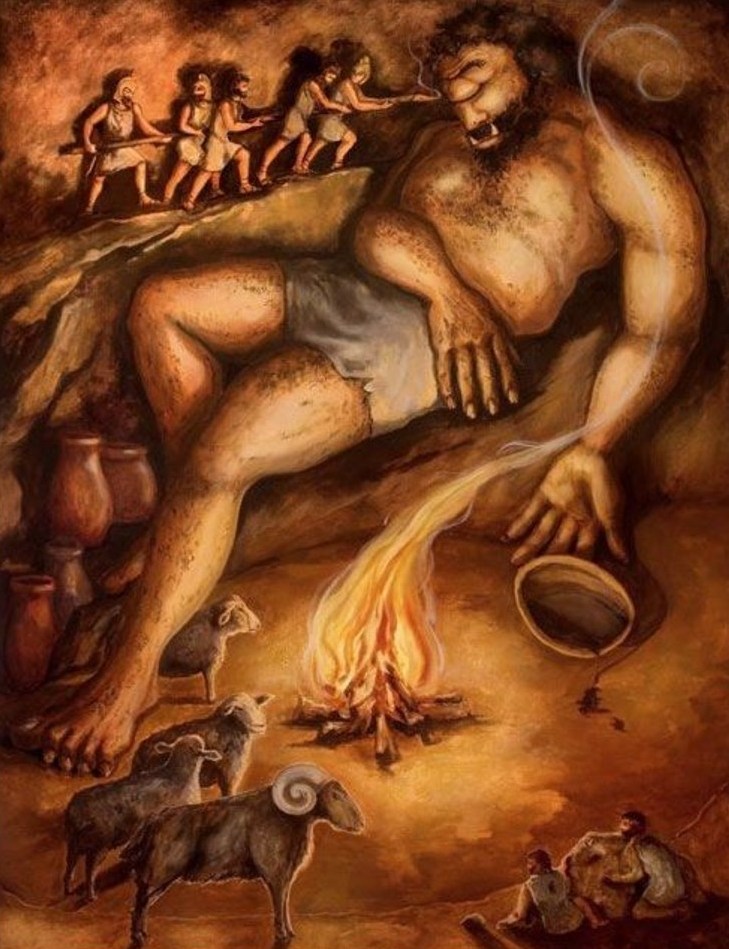
Odysseus’ Cunning Plan: Faced with the dire situation, Odysseus devises a clever plan to escape. He introduces himself to Polyphemus as “Nobody.” When Polyphemus falls asleep from drinking wine, Odysseus and his men heat a wooden stake in the fire and blind the Cyclops by driving the stake into his eye.
Polyphemus’ Cry for Help: In agony, Polyphemus cries out to his fellow Cyclopes for help, saying that “Nobody” is attacking him. The other Cyclopes dismiss his cries, thinking that nobody is harming him. This play on words is a crucial part of Odysseus’ plan.
Escape Under the Sheep: The next morning, Odysseus and his men tie themselves to the bellies of Polyphemus’ sheep in order to escape the cave undetected. When Polyphemus lets his sheep out to graze, he feels the tops of the sheep to ensure the men aren’t escaping on their backs, but unknowingly allows Odysseus and his men to slip away.
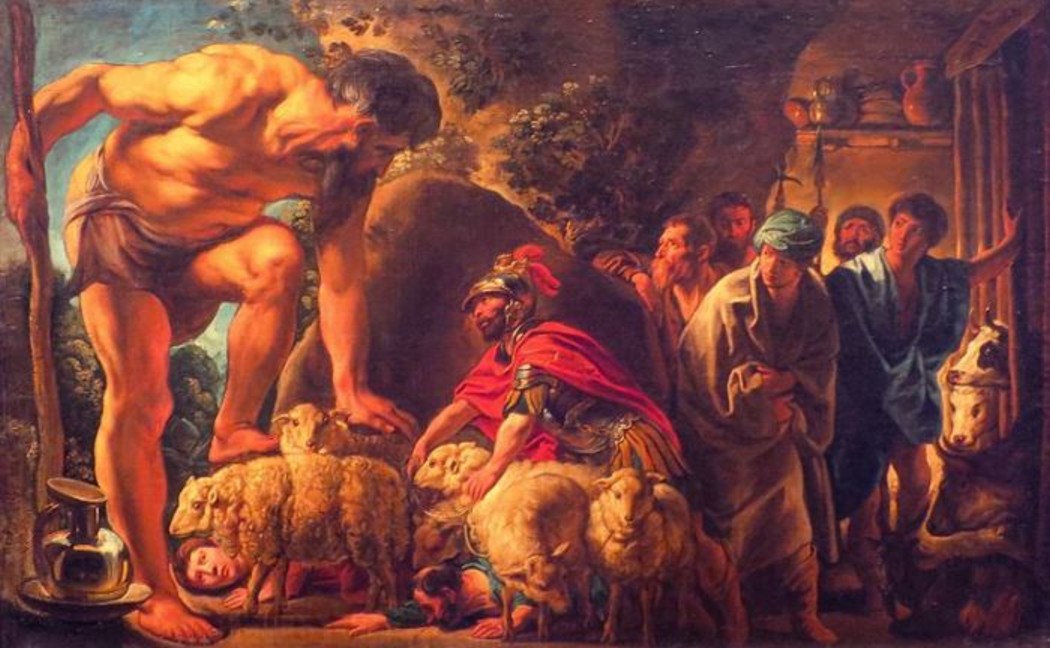
The Name Reveal: As Odysseus and his men sail away, he can’t resist taunting Polyphemus. Odysseus reveals his true name and boasts about his cleverness, taunting the blinded giant that leads to Polyphemus cursing Odysseus with the wrath of his father, Poseidon, which further complicates their journey home.
Significance: The myth of the Cyclops and Odysseus’ encounter with Polyphemus is significant for several reasons. It highlights Odysseus’ intelligence, resourcefulness, and cunning nature, which are key traits that define him as a hero. The encounter also showcases the challenges and dangers that Odysseus and his crew face on their long journey home. Additionally, the episode with Polyphemus serves as a cautionary tale about the consequences of trespassing and the importance of cleverness in the face of danger. The cunning and strategic prowess displayed in this terrible encounter contribute to Odysseus’s enduring reputation as one of the most known figures in Greek mythology.
The myth of the Cyclops has left an indelible mark on literature, art, and popular culture, becoming a timeless symbol of both the hero’s ingenuity and the perils of encountering dangers in far off little known or completely unknown lands.
Warning Against Hubris
In the context of ancient myths, the cyclops often serves as a cautionary figure. Their overwhelming strength and isolation from societal norms can symbolize unchecked hubris or arrogance. The downfall of characters like Polyphemus underscores the dangers of excessive pride and the importance of humility.
Cyclops in Popular Culture
The enduring allure of the cyclops extends to contemporary popular culture. From literature to cinema, the one-eyed giant continues to captivate audiences around the world.
Literature and Fantasy
Authors have drawn inspiration from the cyclops myth to create engaging and imaginative stories. Rick Riordan’s “Percy Jackson” series features cyclops characters like Tyson, who defies expectations with his kindness and loyalty. These modern interpretations often re-imagine the cyclops trope, adding depth and complexity to their characterizations.
Film and Television
Cyclopes have made their mark on the silver screen as well. Perhaps one of the most iconic depictions is found in Ray Harryhausen’s stop-motion animation in the 1958 film “The 7th Voyage of Sinbad.” The cyclops in this film is a menacing and memorable creature that showcases the blend of artistry and storytelling that brings mythical creatures to life.
Video Games
The realm of video games has embraced the cyclops as both formidable foes and intriguing characters. Games like “God of War” feature epic battles against cyclops adversaries, while others offer players the chance to interact with cyclops companions, adding layers of complexity to their portrayals.
Note:
The cyclops, a mythical creature born from ancient tales and fertile imaginations, continues to exert its influence across time and culture. Whether as a symbol of individuality, a cautionary figure against arrogance, or a source of imaginative storytelling, the cyclops remains a potent and multifaceted symbol. As we navigate the realms of myth, science, and popular culture, the cyclops and its associations invite us to ponder the boundaries between reality and fantasy, reminding us of the enduring power of the human imagination.
The Legendary Author:
Homer, the renowned possibly blind Greek poet, is believed to have been born somewhere ranging from the 12th to the 8th centuries BC, potentially along the shores of Asia Minor. Widely celebrated for his monumental works, The Iliad and The Odyssey, Homer’s epic poems have left an indelible mark on Western culture. However, scant information is available about the elusive figure presumed to be their creator.
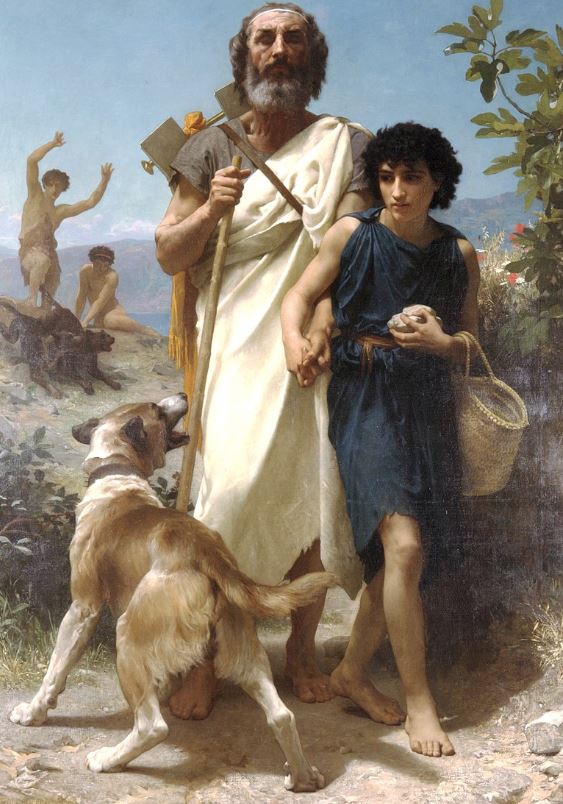
“The Iliad”:
“The Iliad” is an epic poem that centers on the Trojan War, a legendary conflict between the city of Troy and the Greek city-states. The poem spans a period of a few weeks during the final year of the war and explores themes of heroism, honor, fate, and the consequences of war. It follows the exploits of various Greek and Trojan warriors, including Achilles, Hector, and Odysseus. “The Iliad” is renowned for its vivid descriptions, emotional depth, and portrayal of the human experience in the midst of conflict.
“The Odyssey”:
“The Odyssey” is another epic poem attributed to Homer, a captivating tale, and it follows the adventures of Odysseus as he attempts to return home to Ithaca after the fall of Troy. The arduous journey takes him through various mythical lands and introduces him to a range of characters, including gods, monsters, and enchantresses. “The Odyssey” explores themes of heroism, cleverness, loyalty, and the challenges of returning home after a long absence.
Epic Poetry and Influence:
Homer’s works are written in a poetic form known as dactylic hexameter, which is characterized by a rhythmic and metrical pattern that lends itself well to oral recitation. In ancient Greece, epic poetry was often recited by bards at public gatherings, serving as a form of entertainment, education, and cultural preservation.
The influence of Homer’s epics is immeasurable. They played a foundational role in shaping Greek literature and culture and served as touchstones for subsequent writers, philosophers, and artists. The themes explored in Homer’s works, such as the nature of heroism, the relationships between gods and mortals, and the complexities of human emotions, continue to resonate in literature and art to this day.
Homeric Question:
The “Homeric Question” refers to the scholarly debate surrounding the authorship, origins, and transmission of the Homeric epics. Some scholars argue that Homer was a historical figure who composed both poems, while others suggest that the poems were the result of a collective oral tradition that evolved over time.
Legacy:
Homer’s influence extends beyond literature into philosophy, art, and even political thought. His works were studied in ancient Greek education and had a profound impact on the development of Western literary traditions. They provided a common cultural touchstone for the ancient Greeks and continue to inspire discussions about human nature, morality, and the human experience.
While the details of Homer’s life may remain enigmatic, his legacy as a storyteller and poet is indisputable. His works have transcended time and place, leaving an enduring mark on the cultural fabric of history.
A False Lead That Caused People to Believe the Cyclopes to Be Real
Since ancient times up to the beginnings of the modern era, people who found elephant skulls wrongly thought the giant hole in the center, where the trunk would have been, was believed to the giant single eye. But, from Cyclopia we know that there were are and still are real cyclopes, and yet not the super,super big sized; tremendously tall and wide giant cyclopes giants. Read more about this subject below.
In Closing:
In the medical disorder of Cyclopia,there are various forms. There is an advanced type wherein a small eye is in the center of face or forehead and no nose beneath. At times, in other instances, the eye is quite large and no nose beneath. But, there are the most advanced cases of Cyclopia in which there is a single large eye on an otherwise normal face or forehead.
In 1793 there was an infant girl born with a single large eye in her forehead to Monsieur (Mister, Sir) and Madame Clement in Tourcoing, France. This girl cyclops was otherwise normal, but only lived to the age of 15 years. A book by “Ripley’s Believe It Or Not” mentions her and shows an illustration of her.
On the Wikipedia website, there is an article on Cyclopia, including a gallery of pictures; illustrations that go back centuries including a few photographs from, the 1900’s.
https://en.m.wikipedia.org/wiki/Cyclopia
